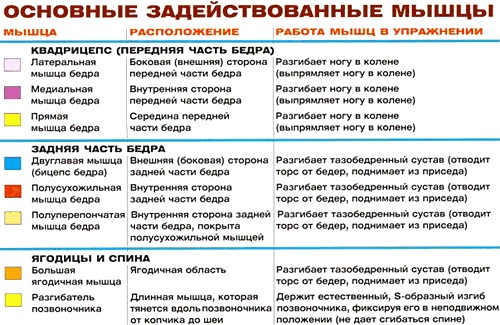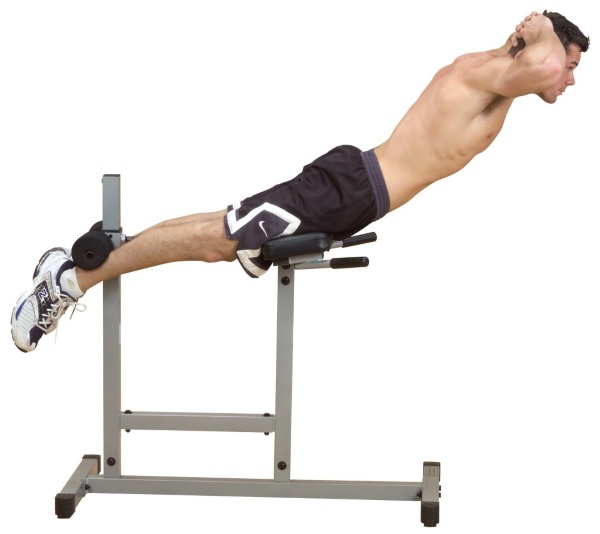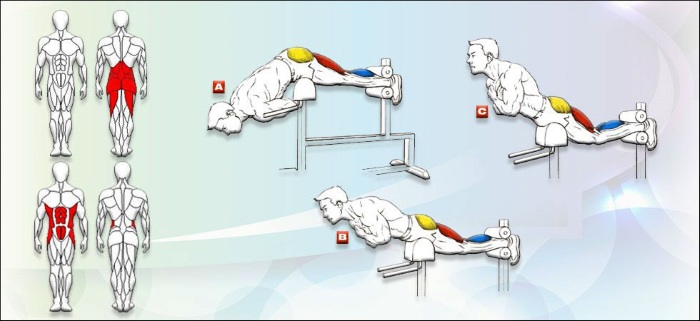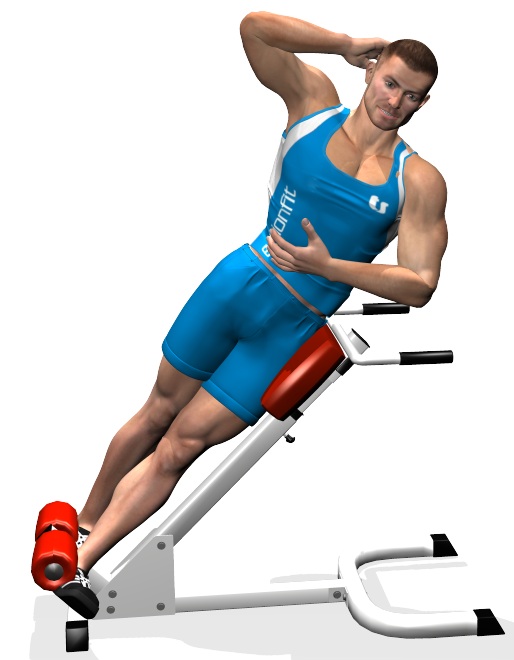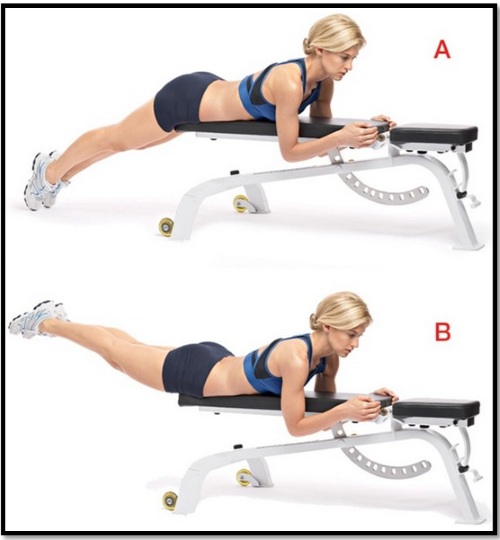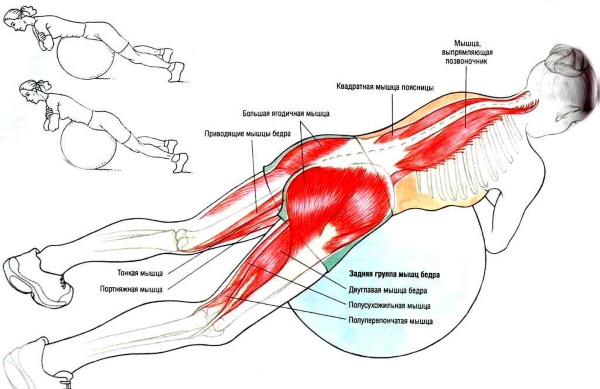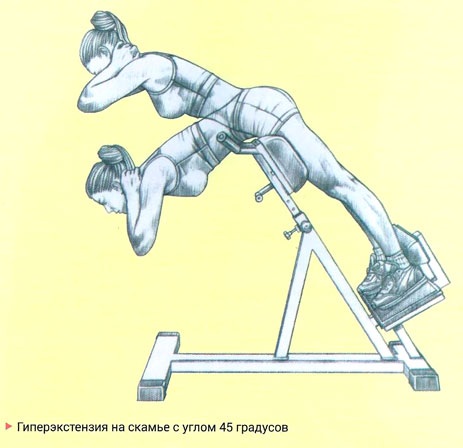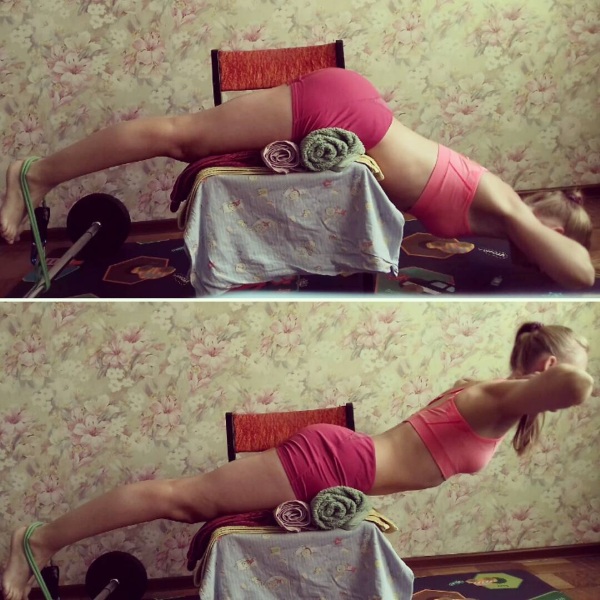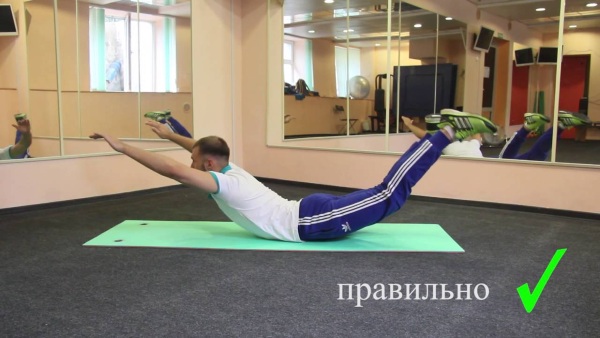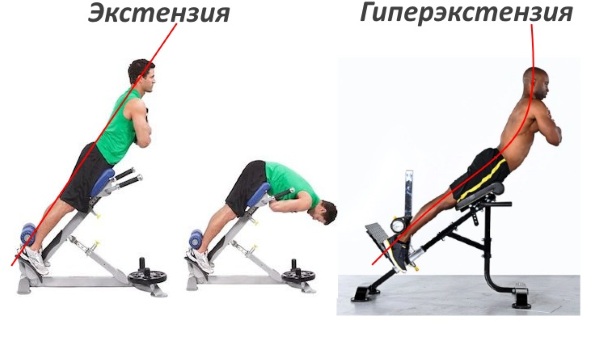A hyperextension is an exercise machine used to perform exercises that develop and strengthen the muscle corset. At the same time, hyperextension is the name of a whole group of exercises.
In a variety of options, this group of exercises is successfully used by both experienced athletes and those who are just starting to play sports in order to strengthen and develop the muscles of the entire back of the body, and is also used as an active component of therapeutic health-improving physical culture for recovery after injuries.
Main muscles worked
During the exercise, several muscle groups interact simultaneously, such as:
- spine extensors;
- internal muscles of the lumbar spine;
- square muscle of the lower back;
- biceps muscle (biceps) of the thigh;
- all small muscles of the back of the thigh;
- large and middle gluteal muscles;
- calf muscles.
Benefit
Hyperextension is a machine used for regular exercise as part of a workout program to work the muscles across the back of the body. For this purpose, the exercise is put at the conclusion of the training complex and when performing, additional weights are used (bar, dumbbells, barbell).
Often hyperextension is carried over to the beginning of a workout as part of a warm-up block of exercises before doing more complex basic back exercises (deadlifts, squats). In this case, weights should not be used. The purpose of the warm-up is only to warm up the muscles and keep them elastic.
For those who have just started playing sports, exercises on the hyperextension simulator are used at the stage of preparing the back for more serious loads before moving on to performing various types of deadlifts and squats.
If pain in the lumbar spine occurs regularly, hyperextension helps to eliminate them in combination with exercises that strengthen the abdominal muscles.

 Don't miss the most popular column article: Body drying for girls. Training program, detailed nutrition menu for a month by day.
Don't miss the most popular column article: Body drying for girls. Training program, detailed nutrition menu for a month by day.Who needs hyperextension?
Hyperextension, a simulator for which you can find in any gym, is one of the basic exercises, so it is not only possible, but also necessary perform the following categories of people:
- adolescents 16-18 years old;
- people starting to play sports (both men and women);
- people suffering from various kinds of back problems;
- people with low household activity;
- adults and people of retirement age.
Contraindications
Unlike a large number of other exercises, hyperextension does not have serious contraindications, but still they are.
Such contraindications include all diseases of the spine in an advanced form or during an exacerbation:
- scoliosis;
- osteochondrosis;
- intervertebral hernia;
- myositis;
- protrusion;
- radiculitis;
- sciatica - inflammation of the sciatic nerve;
- osteoporosis;
- kyphosis;
- lordosis;
- spinal stenosis;
- spondyloarthrosis or facet syndrome;
- age-related changes in the spine.
However, during periods of remission of diseases, as well as during periods of recovery after injuries and previous operations, the hyperextension simulator is used in the program of physical therapy.
Hyperextension Trainer
Hyperextension - a simulator, which is a bench located at an angle of 45, 60 or 90 degrees. The simulator can be either with supports and leg braces, or only with braces. 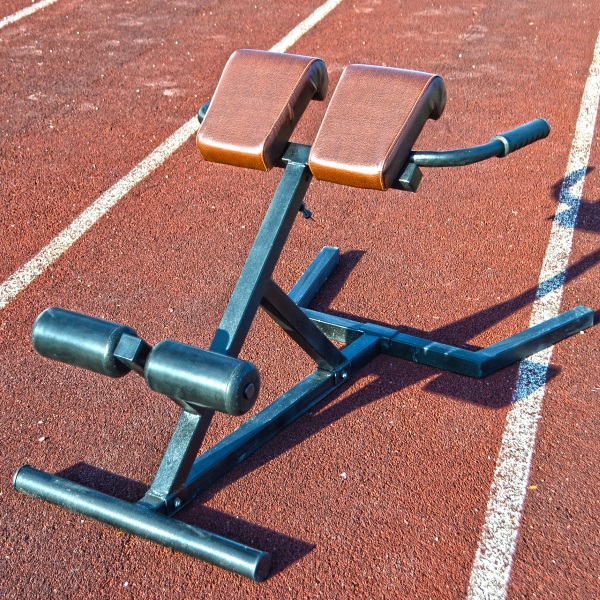
Tips for choosing a simulator
The hyperextension machine must be chosen carefully. The most important thing is not to buy it online. You need to go to the store and try the simulator on the spot.
Important points when choosing a simulator model is that:
- it must fit in height, especially if there is no height adjustment;
- in no case cause unpleasant sensations during the exercise;
- legs must be securely fixed with the lower roller;
- feet should be free to rest on the stops;
- the construction of the simulator must be reliable and stable.
Hyperextension is a simulator that comes in a variety of sizes, so before buying, you should determine the parameters of the place where it will be located. You should also pay attention to the maximum permissible weight of an athlete, which must be selected with a margin of 10-20 kg.
The table shows some models of simulators:
| Specifications / Model | DFC SJ1005 | Oxygen Hyperpress Board | DFC Homegym SUB026 | Body Solid GHY345 |
| Maximum user weight, kg | 110 | 135 | 150 | 227 |
| Folding function | Yes | Yes | No | No |
| Exercise machine weight, kg | 11.5 | 13 | 20 | 29 |
| Exercise machine dimensions (L * W * H), cm | 102*56*79 | 90*60*70 | 131*58.5*89 | 127*66*92 |
| price, rub. | 4990-00 | 9210-00 | 12990-00 | 19200-00 |

 Don't miss the most popular column article: Glutamic acid - what it is, why and how it is used in sports, bodybuilding.
Don't miss the most popular column article: Glutamic acid - what it is, why and how it is used in sports, bodybuilding.When to do hyperextension?
Exercise hyperextension is successfully used in a variety of training programs by beginners and professionals. If the goal of training is to strengthen the muscle corset, then hyperextension is used as the main component of the training program.
It is allowed to use hyperextension as part of the warm-up part of the workout before performing basic exercises that are more voluminous in terms of the number of working muscle groups, such as deadlifts or squats. In this variant, hyperextension is performed without the use of additional weighting.
If hyperextension is used at the beginning of a resistance training session, the back muscles risk losing their elasticity, which will not allow you to perform well either deadlifts or squats.
Another is when hyperextension is used as an isolation exercise that enhances the effect of back training. For this purpose, it is transferred to the final part of the set of exercises. In this case, hyperextension is performed with additional weighting, which is selected in accordance with the level of the athlete's training.
General Tips
Before proceeding directly to the exercise, it becomes necessary to set the appropriate level of the simulator height:
- The pelvic area should be located exactly on the pillow.
- The upper part of the body, starting from the lower back, should be overhanging.
- It is necessary to make sure that the legs are firmly and securely fixed by the rollers, and the feet are level on the platform.
- It is strongly recommended to keep your back flat and keep your back arch throughout the entire exercise process.
- Body movements should not be sharp, the press must be tense.
- You need to bend at the top point until a well-felt feeling of tension in the muscles and ligaments, but not pain.
Execution techniques
Today, there are a number of options for performing the exercise, both with the use of a simulator and without it.
To perform in the gym, the following types of hyperextension exercises are distinguished:
- horizontal;
- lateral;
- reverse (reversible);
- on fitball;
- with a round back;
- hyperextension at an angle.
Horizontal hyperextension
Take the starting position:
- The housing must be parallel to the floor.
- The lower anchoring roller should be on the Achilles tendon.
- The upper fixation roller is located just below where the body folds.
- The gaze is directed strictly in front of you.
- Hands are folded on the chest or are near the temples.
Technics:
- During inhalation, the body leans forward smoothly to an angle of approximately 70 degrees.
- The back is kept straight.
- During exhalation, the body slowly returns to its original position.
- The scheduled number of retries is in progress.
Lateral hyperextension
The exercise is designed to actively work out the oblique abdominal muscles, more precisely, their lateral parts. To perform this exercise correctly, you must use an incline hyperextension machine.
Take the starting position:
- The body is located sideways on the simulator cushion.
- Legs are placed together or one behind the other on the lower platform.
- The lower leg rests against the lower fixation roller.
- The outer thigh should rest at or slightly below the pelvic floor on the cushion of the machine.
- Hands are folded behind the head or folded over the chest.
Technics:
- During inhalation, the body gradually descends down as far as possible.
- During exhalation, the body returns no less smoothly to an upright position and twisting to the side is performed until the oblique muscles of the abdomen are stretched.
- You need to do the same number of repetitions on the right and left sides of the body.
Reverse hyperextension
Reverse (aka reverse) hyperextension refers to isolating exercises for the gluteal and dorsal muscles, as well as for the muscles of the back of the thigh.
Take the starting position:
- The body is placed "face down", either on a special simulator, or on a simple bench.
- The emphasis of the body falls on its upper part.
- The legs are fully extended beyond the edge of the bench, brought together and lowered to the floor.
- Hands hold on to special handles, or to the edge of the bench.
Technics:
- During exhalation, the legs are raised to a horizontal position, the gluteal muscles are in tension.
- The gaze is directed strictly in front of you.
- At the highest point during exhalation, it is necessary to fix the position of the legs for a few seconds and during inhalation, smoothly return the legs to their original position, do not touch the floor.
Fitball hyperextension
This version of the exercise due to the cushioning of the ball is suitable for pregnant women and people suffering from lower back pain.
Take the starting position:
- The body is "face down" on the ball.
- Legs are placed with feet on the floor, resting on it with heels.
- The upper body is in front of the ball.
Technics:
- Bend your torso forward as far as the ball allows.
- The shoulders must be straightened, and the deflection in the lower back must be strictly observed.
- Smoothly return to the starting position.
Round back hyperextension
This option works out the gluteal muscles and the entire back of the thigh.
Take the starting position:
- The body is "face down" on the simulator.
- The legs are fixed.
- The back is rounded.
- The arms are folded in a cross on the chest.
Technics:
- While inhaling, slowly lower the body down.
- In this case, the back must be rounded even more.
- On exhalation, rise smoothly upward, maintaining a rounded back position.
Angled hyperextension
Before starting the exercise, the hyperextension machine is adjusted to the height of the athlete, if its design allows it.
Initial position:
- The body is face down.
- The top roller is slightly below the body fold line.
- Ankles or heels are secured with a lower bolster (not calves!).
- The back is straight with a bend in the lower back.
- The arms are crossed over the chest or placed near the temples.
Technics:
- Maintaining an even position of the back, gently tilt the body forward while inhaling to an angle of 90 degrees.
- Also, as you exhale, rise to the starting position and fix it for a few seconds.
- Perform the required number of repetitions and approaches.
With or without extra weight: which is better?
Doing hyperextension with or without extra weight depends on the purpose for which the exercise is used in the training program.
If the goal is to warm up the muscles before heavier exercises (deadlifts, squats), then weights should not be used under any circumstances. The use of weights in a warm-up often leads to the fact that the muscles lose their elasticity, that is, they "clog up", and it will not be possible to fully perform the rest of the exercises.
If the hyperextension exercise is used as the main exercise in the training complex, or is aimed at enhancing the effect of back training at the end of the complex, then weights are definitely used.
However, before using the weights, you need to make sure that your back muscles are strong enough. The trainer will help to clarify this question. He will also pick up the weights that match your fitness level.
Hyperextension at home
The hyperextension exercise is one of those exercises that can be done almost anywhere without a machine.
Here are some options for doing the exercise:
- hyperextension in the yard;
- hyperextension on the floor or boat;
- hyperextension on the couch.
The "fitball hyperextension" option described above can also be performed at home if a suitable projectile is present for this.
Hyperextension in the yard
If there are two horizontal pipes of different heights in the yard or on the street, then hyperextension can be performed on them.
Take the starting position:
- The heels are located under the downtube.
- The legs or hips are located on the upper tube.
- The back is in line with the legs.
- The arms are crossed over the chest or placed near the temples.
It is recommended to put something soft on the upper tube to avoid bruising.
Technics:
On inhalation, the body smoothly drops down as far as possible and on exhalation it smoothly returns to its original position.
Floor or boat hyperextension
To perform this exercise option, you will need a gymnastic mat:
- Take the starting position, lying on the floor, face down.
- The arms are stretched along the body or forward (complicated option).
Technics:
On exhalation, it is necessary to simultaneously raise the head, upper body and legs, as far as the flexibility of the body allows. The return to the starting position occurs on inhalation.
Hyperextension on the couch
In this option, you will need a partner who will fix the legs, and a not very soft, stable surface.
Take the starting position:
- The body is positioned so that the edge of the surface clearly falls on the fold line.
- The partner holds the legs.
- The arms are placed in a cross on the chest.
- The back maintains a deflection.
Technics:
During inhalation, the body slowly descends downward; during exhalation, it rises to the horizontal. The required number of repetitions is performed.
Common mistakes when doing hyperextension
Often people are frivolous about correct exercise technique, and hyperextension is no exception.
The most common mistakes are:
- performing the exercise at the maximum angle of inclination (90 degrees). This can be done only if there are no problems with the spine at all. The average tilt angle is considered to be an angle of 60 degrees;
- excessive deflection in the lumbar region at the top point. In most cases, this leads to severe injury (displacement or outflow) of the spine;
What is the difference between extension and hyperextension - excessive deflection in the lumbar region at the lowest point when starting upward movement, which in most cases also leads to a dangerous spinal injury;
- a rounded back removes stress from the target muscles. An exception is the option of performing an exercise for the buttocks;
- performing the exercise in maximum amplitude, combining the maximum angle of inclination and excessive deflection in the lumbar region at the top point. It looks like a pendulum and often leads to pinching of the spine;
- excessive speed of the exercise in jerks;
- trying to bend the knees. In addition to the extremely undesirable load on the knees, this leads to the fact that the load from the back is redistributed throughout the body and does not give the desired effect;
- wrong hand position. The arms should be crossed over the chest, either at the temples, or behind the head, but not in the "lock";
- using additional weights before the back muscles have strengthened. Excessive haste in this matter leads to muscle strain.
Combining all of the above, it turns out that hyperextension is a powerful exercise that:
- practically has no contraindications;
- allows you to strengthen, develop and keep your back healthy;
- any person can perform, regardless of the level of sports training;
- so versatile that it can be done without equipment anywhere.
Hyperextension is just as versatile as an exercise. It can be purchased and installed in a house, apartment or country house. It will not take up much space, but it will provide invaluable back assistance.
Article design: Mila Friedan
Hyperextension video
Back straightener hyperextension:

